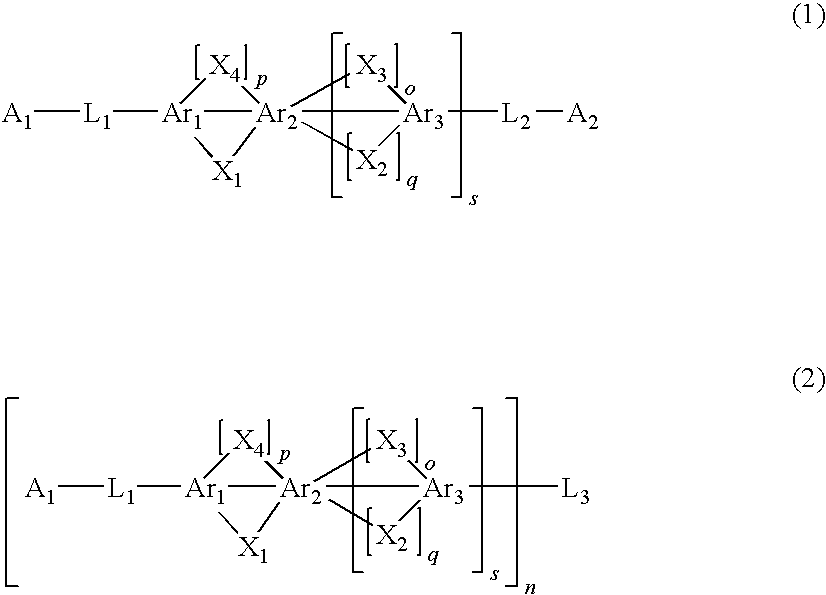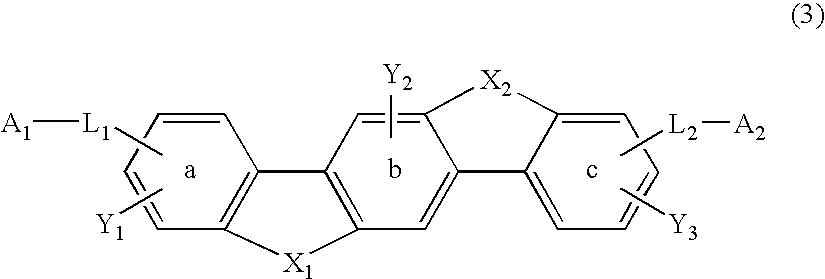Material for organic electroluminescence device and organic electroluminescence device using the same
a technology of electroluminescence device and material, which is applied in the direction of discharge tube luminescnet screen, natural mineral layered products, anthracene dyes, etc., can solve the problems of low luminous efficiency, low luminous efficiency, and insufficient luminous efficiency of the device to be put into practical use, so as to achieve long life and high luminous efficiency
- Summary
- Abstract
- Description
- Claims
- Application Information
AI Technical Summary
Benefits of technology
Problems solved by technology
Method used
Image
Examples
synthesis example 1
Synthesis of Compound No. 11
[0295]
[0296]Compound 1 (2.6 g, 10 mmol), 2-bromobenzofuran (5.0 g, 20 mmol), CuI (1.9 g, 10 mmol), transcyclohexane 1,2-diamine (3.4 g, 30 mmol), K3PO4 (8.5 g, 40 mmol), and 1,4-dioxane (10 mL) were loaded into a three-necked flask, and the mixture was refluxed under an argon atmosphere for 10 hours.
[0297]After the completion of the reaction, the resultant was cooled to room temperature. The resultant sample was transferred to a separating funnel, and water (50 mL) was charged into the funnel. Then, the mixture was extracted with CH2Cl2. The resultant sample was purified by silica gel column chromatography. The purified product was concentrated and exsiccated, and was then recrystallized twice, whereby a white powder (Compound No. 11) was obtained. The powder was purified by sublimation, whereby a white solid was obtained in an amount of 0.7 g in 12% yield.
[0298]FD-MS C42H24N2O2: theoretical value 588, observed value 588
synthesis example 2
Synthesis of Compound No. 40
[0299]
[0300]Compound 2 (2.6 g, 10 mmol), 2-bromobenzofuran (5.0 g, 20 mmol), CuI (1.9 g, 10 mmol), transcyclohexane 1,2-diamine (3.4 g, 30 mmol), K3PO4 (8.5 g, 40 mmol), and 1,4-dioxane (10 mL) were loaded into a three-necked flask, and the mixture was refluxed under an argon atmosphere for 10 hours.
[0301]After the completion of the reaction, the resultant was cooled to room temperature. The resultant sample was transferred to a separating funnel, and water (50 mL) was charged into the funnel. Then, the mixture was extracted with CH2Cl2. The resultant sample was purified by silica gel column chromatography. The purified product was concentrated and exsiccated, and was then recrystallized twice, whereby a white powder (Compound No. 40) was obtained. The powder was purified by sublimation, whereby a white solid was obtained in an amount of 1.9 g in 33% yield.
[0302]FD-MS C42H24N2O2: theoretical value 588, observed value 588
synthesis example 3
Synthesis of Compound No. 47
[0303]
[0304]Compound 3 (2.6 g, 10 mmol), 2-bromobenzofuran (5.0 g, 20 mmol), CuI (1.9 g, 10 mmol), transcyclohexane 1,2-diamine (3.4 g, 30 mmol), K3PO4 (8.5 g, 40 mmol), and 1,4-dioxane (10 mL) were loaded into a three-necked flask, and the mixture was refluxed under an argon atmosphere for 10 hours.
[0305]After the completion of the reaction, the resultant was cooled to room temperature. The resultant sample was transferred to a separating funnel, and water (50 mL) was charged into the funnel. Then, the mixture was extracted with CH2Cl2. The resultant sample was purified by silica gel column chromatography. The purified product was concentrated and exsiccated, and was then recrystallized twice, whereby a white powder (Compound No. 47) was obtained. The powder was purified by sublimation, whereby a white solid was obtained in an amount of 1.5 g in 25% yield.
[0306]FD-MS C42H24N2O2: theoretical value 588, observed value 588
PUM
| Property | Measurement | Unit |
|---|---|---|
| luminous wavelength | aaaaa | aaaaa |
| work function | aaaaa | aaaaa |
| work function | aaaaa | aaaaa |
Abstract
Description
Claims
Application Information
 Login to View More
Login to View More - R&D
- Intellectual Property
- Life Sciences
- Materials
- Tech Scout
- Unparalleled Data Quality
- Higher Quality Content
- 60% Fewer Hallucinations
Browse by: Latest US Patents, China's latest patents, Technical Efficacy Thesaurus, Application Domain, Technology Topic, Popular Technical Reports.
© 2025 PatSnap. All rights reserved.Legal|Privacy policy|Modern Slavery Act Transparency Statement|Sitemap|About US| Contact US: help@patsnap.com



